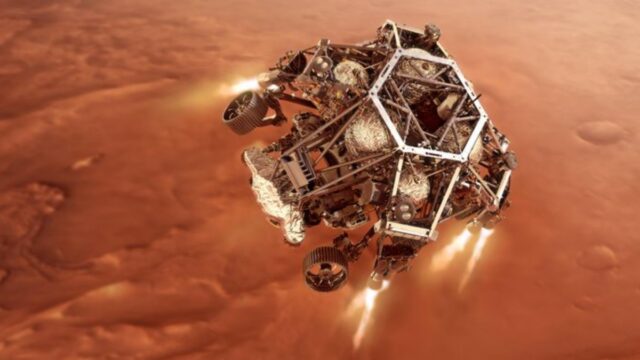It seems that in 2020 there was no place for science, the entire media space was occupied by the news of the ongoing pandemic. And when to work on discoveries, if there are quarantines all year round, when you can only play in online casinos, then diseases, then the budget is cut. For some scientific events, COVID-19 became the reason for the postponement, as in the case of the Russian-European project “ExoMars-2020”, some had to be canceled altogether. However, despite all the difficulties, a lot was accomplished in world science in 2020. Fontanka has selected the most interesting events from the world of science.
Sampling Soil from the Moon
Contents
Chinese lunar mission “Chang’e-5”. The collection of soil from the Moon is a very important event for science and, alas, because of its complexity and high cost, it is very rare. The last time the lunar regolith was brought by the Soviet station “Luna-24” back in 1976. Forty-four years later, the soil from the Moon was collected and delivered to Earth by the Chinese mission “Chang’e-5”.
It should be said that this is one of the most difficult modern space missions. The Chinese not only made a soil sampling, but practically imitated a manned mission in miniature. The orbital module remained in the lunar orbit, the landing module landed on the surface, and then the take-off module starting from it went into orbit and there docked with the orbital. Such a long chain became ideal training for the Chinese astronautics ahead of the planned landing of astronauts at the end of the decade casino sites without gamstop.
The result of “Chang’e-5” was the return to Earth of a capsule containing 1731 grams of regolith. This is slightly less than the planned two kilograms, but still a complete success. The Chinese scientists explained the lack of soil by the fact that during the sampling, the lander bumped into fragments of shale and the drill stalled at a meter depth.
Superconductivity at Room Temperature
American physicists have discovered superconductivity in carbon-containing hydrogen sulfide at room temperature. Previously, it was believed that this quality – the ability to conduct electric current with zero resistance – exists only at ultra-low temperatures, literally several tens of degrees above absolute zero. In the eighties of the last century, the first “high-temperature superconductors” were found – ceramic materials based on mixed copper oxide. They lose the property of superconductivity already at a temperature of -109 degrees Celsius, which is still very difficult to use.
And now American physicists under the leadership of Ranga P. Dias from the University of Rochester were able to synthesize a high-temperature superconductor for the first time. It retains its properties even at temperatures of 15 degrees Celsius. True, there is one “but”: this was achieved only at a pressure of 2.67 million atmospheres.
In order to provide it, scientists used a “diamond anvil”. This is the name of a chamber with a sample, which is clamped between the faces of two diamonds and allows you to observe solid materials at pressures up to several million atmospheres.
So, alas, while using a superconductor created from a crystal based on hydrogen sulfide and methane with an increased hydrogen content, it will not work in real life. However, this is already a very serious reserve for future discoveries.
Mission to Asteroid
The Japanese space mission Hayabusa-2, which lasted for six years, has come to an end. Its goal was to deliver soil samples from the asteroid (162173) Ryugu. Launched in 2014, the device traveled to the asteroid for several years, and then spent another year in the same orbit and performed various experiments.
In order to get the ground, “Hayabusa-2” first fired at the asteroid with tantalum bullets, while he himself was as close as possible so that the particles of the asteroid after the shot fell into a special chamber. Then the spacecraft moved away and dropped a special explosive device with a copper tip on the asteroid in order to achieve large destruction of the asteroid’s surface. The result of the explosion was a ten-meter crater on the asteroid. From it, Hayabusa-2 took some more samples to another chamber.
On December 5, 2020, at about 21:00 Moscow time, the probe dropped a capsule with soil samples from an asteroid onto Earth. The capsule landed in Australia at Woomera Proving Grounds as planned. By now, the capsules have already been opened, the soil from the asteroid turned out to be like black sand with small fragments of stones. However, its exact composition has yet to be studied non gamstop bookies.
Exploring the Universe
The Russian-European project “Spectr-RG” also continues to supply scientific discoveries. In 2019, this space-based X-ray observatory was launched into the L2 Lagrange point of the Earth-Sun system. Spectrum-RG is equipped with two telescopes – the German eRosita and the Russian ART-XC.
In December 2020, telescope completed a re-survey of the entire sky. Among the sources he registered, several dozen previously unknown objects were discovered, both in our Milky Way galaxy and beyond, including supermassive black holes surrounded by a layer of cold gas and invisible in soft X-rays. Some of the recorded sources exhibit strong variability, as evidenced by a comparison of the maps of the first and second surveys.
Most likely, in the near future, Russian scientists will publish articles on the structures found and how this knowledge can affect modern cosmological theories (properties and evolution of the Universe as a whole).


